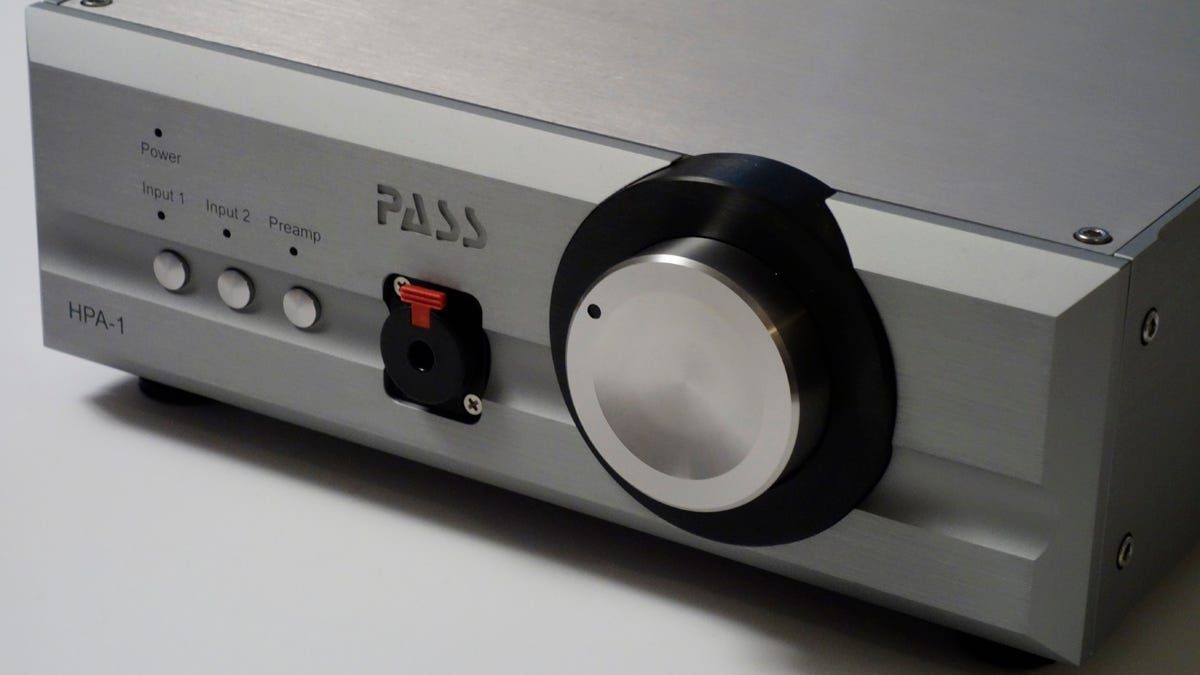Extreme performance: The Pass Labs HPA-1 headphone amplifier
The Audiophiliac spends quality time with an extraordinary headphone amplifier.

As the selection of cost-no-object headphones grows, I keep looking for the very best headphone amplifiers. This all-new amp from Pass Labs, the HPA-1, should satisfy all but the most devout audiophiles. The power transformer was custom designed specifically for this amplifier; the circuits are low-feedback, wide-bandwidth designs employing JFET transistor input stages and Class A direct-coupled MOSFET output stages. Tech-talk translation: the HPA-1 is a no-holds-barred design -- power output tops out at 3.5 watts per channel, which is a lot for a headphone amp. You get two sets of stereo analog RCA inputs, stereo RCA preamplifier outputs, and a high-quality, locking 6.3 mm headphone jack on the front panel.
Pass Labs' Jam Somasundram designed the HPA-1, and the project consumed a year of his time. The amp's half-inch machined faceplate, aircraft-grade aluminum chassis panels and solid aluminum volume control knob match other Pass Labs electronics. Fit and finish are absolutely first class. The amp measures 4.5 by 11 by 13 inches; it weighs 14 pounds. Pass Labs has been designing and building world-class electronics in California since 1991.
Pass Labs HPA-1, with Hifiman Edition X headphones
Fun fact: I played more headphones over the HPA-1 than any other amp I've reviewed -- it was that good. In the beginning I focused only on top-shelf models, starting with a Hifiman HE1000 ($3,000). The clarity of this headphone and its sweet midrange, sharply focused imaging and excellent comfort make for a compelling combination with the HPA-1. Resolution and clarity are exceptional, but I never felt the HPA-1 and HE1000 went overboard with dredging up too much information that made less-than-stellar recordings unlistenable, most recordings sounded great.
The HE1000 is really good, but the Abyss AB-1266 ($5,500) is the best sounding headphone I own, and again, the HPA-1 only made it better. The deepest bass frequencies were clearer, soft-to-loud dynamic contrasts were more viscerally alive, and the out-of-head imaging was more spacious than before. Transparency is state of the art, beating even the electrostatic Stax and Koss headphones I currently have at home.
At this point I popped on a more affordable headphone: one of my favorites that came out in 2015, the AudioQuest NightHawk ($600). It's a lusciously warm and rich sounding design, and so it was with the HPA-1, but with newfound transparency. Quiet details and "air" on my best recordings were brought to life by the HPA-1 with the NightHawk.
My 10-year-old Grado RS-1 headphones ($600 when new) can sound a wee bit bright with other amps, but they were more relaxed with the HPA-1, playing Johnny Cash and Willie Nelson's "VH1 Storytellers" CD. Johnny and Willie's vocals in particular were thrilling, more believably realistic than what I've heard before with the RS-1.
To put the HPA-1's sound in context, I compared it with the excellent Oppo HA-1 ($1,200) headphone amp, and it was immediately clear the HPA-1 was significantly more transparent and dynamically alive than the Oppo. That one is no slouch, but the HPA-1 is in another league. The HPA-1 liberates music, the Oppo HA-1 put a veil over it. To be fair about this, the HPA-1 is three times as expensive as the HA-1, and the Oppo HA-1 has an onboard digital converter; the HPA-1 does not.
The Pass Labs HPA-1's rear panel
The only headphone in my collection that didn't click with the HPA-1 was the latest version of the Audeze LCD-4 headphone. The amp's transparency and "live" quality were muted, but I have no idea why the mismatch occurred.
With other headphones, the HPA-1 had an effortless quality that made recorded music sound more like the real thing. That was certainly true when I played a live Elliot Smith cut, "Say Yes," and I could almost feel Smith singing into the mic, the connection to his vocal was that strong.
The HPA-1 is also a first-rate stereo preamp, but only if you can get by with just two inputs and no remote control. Is the HPA-1 the best sounding headphone amp I've heard? No, that honor goes to the Nagra HD-DAC, but it runs $28,310; the HPA-1 goes for a "mere" $3,500!
The Pass Labs HPA-1 is a reference-grade component designed with well-heeled headphone enthusiasts in mind -- ones that already own at least one world-class headphone. If that describes you, I hope you can get to hear the HPA-1. For everybody else, there's a fair chance this level of performance will come down in price, in 5 or 10 years.

